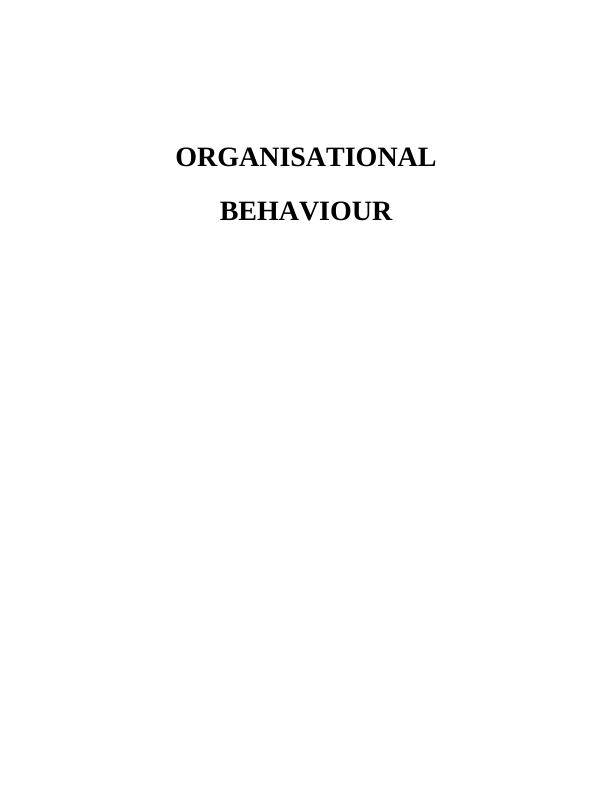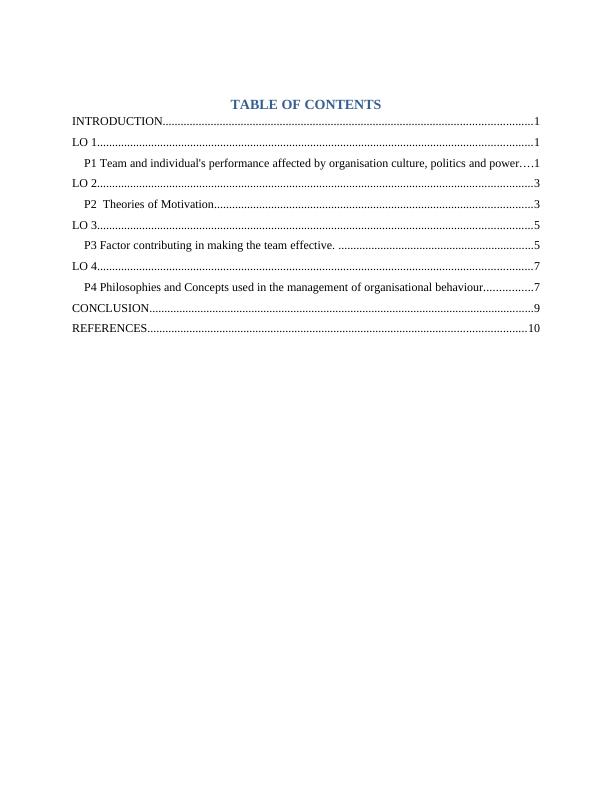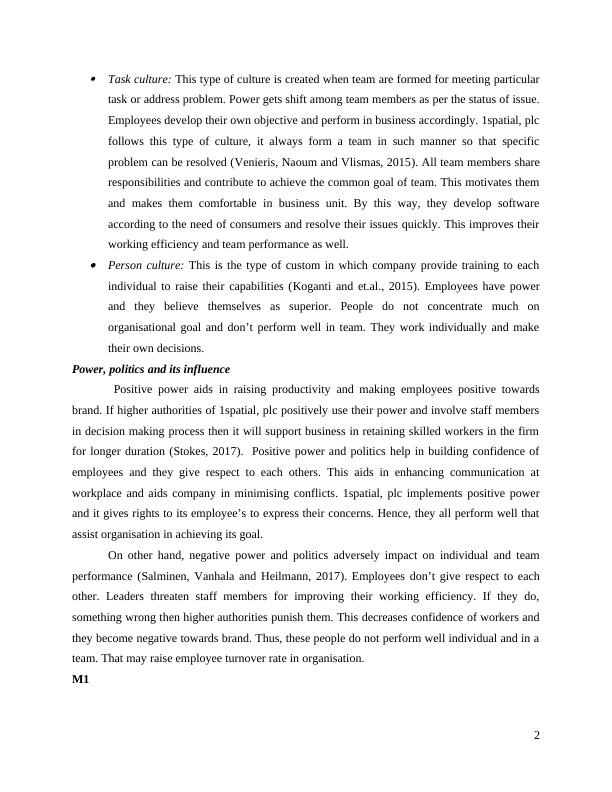Organisational Behaviour Management
15 Pages4895 Words421 Views
Added on 2021-01-02
Organisational Behaviour Management
Added on 2021-01-02
ShareRelated Documents
ORGANISATIONAL BEHAVIOUR

TABLE OF CONTENTSINTRODUCTION...........................................................................................................................1LO 1.................................................................................................................................................1P1 Team and individual's performance affected by organisation culture, politics and power....1LO 2.................................................................................................................................................3P2 Theories of Motivation..........................................................................................................3LO 3.................................................................................................................................................5P3 Factor contributing in making the team effective. .................................................................5LO 4.................................................................................................................................................7P4 Philosophies and Concepts used in the management of organisational behaviour................7CONCLUSION................................................................................................................................9REFERENCES..............................................................................................................................10

INTRODUCTIONOrganisation behaviour (OB) is the study of predicting and controlling over humanbehaviour in organisation. It assists business in building healthy relationship with people atworkplace and enhancing coordination among them (Pereira, 2017). Companies are required tomotivate its workers so that it can make them satisfied and can retain them in entity for longerduration. These satisfied people contribute well in raising operational efficiency of enterprise.Present study is based on 1spatial, plc that conducts its operations in the field of computersoftware. Its main agenda is to raise its profit and sustain in market for longer duration. Currentassignment will explain culture, power, politics and their influence on the firm. Furthermore, itwill evaluate various motivational theories that enable business in effective achievement of goal.In addition, report will determine factors that form an effective team as opposed to an ineffectiveteam. Study will apply concepts and philosophies of OB with references to 1spatial, plc. LO 1P1 Team and individual's performance affected by organisation culture, politics and powerOrganisational culture and its influenceOrganisation culture reflects values, believes, perception of business unit. Culture guideshuman behaviour in business unit significantly. Each firm has its own culture that describesindividual autonomy and level of support of management in enterprise. Handy’s cultural modeldefines four kinds of culture in organisation:Power: It explains that power always held in the hand of few people those who are athigher position in organisation (Chumg and et.al., 2016). There are strict rules and eachemployee is bound to follow these regulations. In such kind of culture performance ofworkers are being judged on the bases of how they perform and how they act in firm.Though such kind of culture is helpful in making swift decision but it staff has to workunder pressure. That demotivates individuals and affects their working performance aswell. They don’t feel happy and do not perform well in team. Role Culture: It is another kind of culture in which everyone has defined their own roleand responsibilities (Sherr and et.al., 2016). Leaders have to behave bureaucratic; personwho has at higher position has high power. This culture influences individual behaviourbecause people those are at lower level do not get any right to make decision that impacton the moral. 1

Task culture: This type of culture is created when team are formed for meeting particulartask or address problem. Power gets shift among team members as per the status of issue.Employees develop their own objective and perform in business accordingly. 1spatial, plcfollows this type of culture, it always form a team in such manner so that specificproblem can be resolved (Venieris, Naoum and Vlismas, 2015). All team members shareresponsibilities and contribute to achieve the common goal of team. This motivates themand makes them comfortable in business unit. By this way, they develop softwareaccording to the need of consumers and resolve their issues quickly. This improves theirworking efficiency and team performance as well.Person culture: This is the type of custom in which company provide training to eachindividual to raise their capabilities (Koganti and et.al., 2015). Employees have powerand they believe themselves as superior. People do not concentrate much onorganisational goal and don’t perform well in team. They work individually and maketheir own decisions.Power, politics and its influence Positive power aids in raising productivity and making employees positive towardsbrand. If higher authorities of 1spatial, plc positively use their power and involve staff membersin decision making process then it will support business in retaining skilled workers in the firmfor longer duration (Stokes, 2017). Positive power and politics help in building confidence ofemployees and they give respect to each others. This aids in enhancing communication atworkplace and aids company in minimising conflicts. 1spatial, plc implements positive powerand it gives rights to its employee’s to express their concerns. Hence, they all perform well thatassist organisation in achieving its goal.On other hand, negative power and politics adversely impact on individual and teamperformance (Salminen, Vanhala and Heilmann, 2017). Employees don’t give respect to eachother. Leaders threaten staff members for improving their working efficiency. If they do,something wrong then higher authorities punish them. This decreases confidence of workers andthey become negative towards brand. Thus, these people do not perform well individual and in ateam. That may raise employee turnover rate in organisation. M12

End of preview
Want to access all the pages? Upload your documents or become a member.
Related Documents
Organisational Behaviour: Team and individual's performance affected by organisation culture, politics and powerlg...
|16
|5440
|92
Organizational Behaviour of 1Spatiallg...
|16
|5054
|181
(Solved) Organisational Behaviour - PDFlg...
|16
|5029
|372
Concepts & Philosophies of Organisational Behaviourlg...
|15
|4720
|459
Organizational Behaviour - 1Spatial Assignmentlg...
|17
|4483
|445
Organisational Behaviour Notes PDFlg...
|17
|5049
|206
